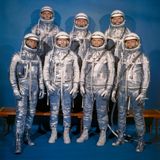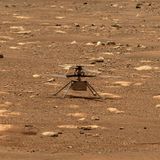RECENT ARTICLES
So Long TNT, There's a New Explosive in Town
The chemistry of explosives is a delicate matter. A little less carbon, a little more nitrogen, and the right amount of oxygen can transform a relatively inert substance into quite the showstopper. For more than 100 years, TNT has been the premier combination of chemicals for blowing things up, and it's even used as a metric to measure the yield of nuclear explosions and other monumental blasts. But out of Los Alamos National Laboratory and the Army Research Laboratory has discovered a new chemical, bis-oxadiazole (C6H4N6O8), that has many of the advantages of TNT, is thought to be less...…The chemistry of explosives is a delicate matter. A little less carbon, a little more nitrogen, and the right amount of oxygen can transform a relatively inert substance into quite the showstopper. For more than 100 years, TNT has been the premier combination of chemicals for blowing things up, and it's even used as a metric to measure the yield of nuclear explosions and other monumental blasts. But out of Los Alamos National Laboratory and the Army Research Laboratory has discovered a new chemical, bis-oxadiazole (C6H4N6O8), that has many of the advantages of TNT, is thought to be less...WW…

How the 'right stuff' to be an astronaut has changed over the years
The first humans flew into space nearly 60 years ago from the deserts of southern Kazakhstan and the Atlantic shores of Florida. Since then, we’ve learned a lot about what it takes to leave the planet.NASA had a problem 250 miles above Earth. Two astronauts, Luca Parmitano and Chris Cassidy, were crawling along the outside of the International Space Station, performing routine maintenance in 2013, when Parmitano noticed liquid accumulating in his helmet.“It feels like a lot of water,” the Italian astronaut reported over the radio—a worrisome development because in microgravity, the water...…The first humans flew into space nearly 60 years ago from the deserts of southern Kazakhstan and the Atlantic shores of Florida. Since then, we’ve learned a lot about what it takes to leave the planet.NASA had a problem 250 miles above Earth. Two astronauts, Luca Parmitano and Chris Cassidy, were crawling along the outside of the International Space Station, performing routine maintenance in 2013, when Parmitano noticed liquid accumulating in his helmet.“It feels like a lot of water,” the Italian astronaut reported over the radio—a worrisome development because in microgravity, the water...WW…

NASA's Mars helicopter gets ready to make history
Please be respectful of copyright. Unauthorized use is prohibited.NASA is nearly ready to attempt the first flight on another planet. The space agency’s small helicopter, called Ingenuity, has been deposited in a flat area on Mars, and it is running through a series of final tests before it tries to lift into the thin Martian air. Ingenuity’s first flight was originally slated for April 11, but the mission hit a snag during a pre-flight test. While trying to spin the helicopter’s rotors at full speed without leaving the ground, Ingenuity’s onboard computer ended the test early. NASA...…Please be respectful of copyright. Unauthorized use is prohibited.NASA is nearly ready to attempt the first flight on another planet. The space agency’s small helicopter, called Ingenuity, has been deposited in a flat area on Mars, and it is running through a series of final tests before it tries to lift into the thin Martian air. Ingenuity’s first flight was originally slated for April 11, but the mission hit a snag during a pre-flight test. While trying to spin the helicopter’s rotors at full speed without leaving the ground, Ingenuity’s onboard computer ended the test early. NASA...WW…
- Total 3 items
- 1